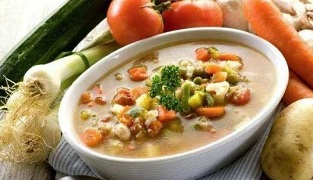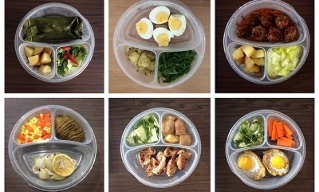
Inflammation of the gastric mucosa is uncomfortable and painful.
In addition to drug therapy, a child with gastritis is of great importance - "real" products do not irritate the walls, contribute to epithelial regeneration and maintain remission of the disease.
What to eat with gastritis
There are many reasons why gastritis develops:
- Improper diet, with predominance of dry, spicy, hot foods;
- Unbalanced diet;
- Alcohol abuse, soda;
- Taking certain medications that irritate the lining of the stomach
Before talking about what you can eat with gastritis and what you should refuse, you need to learn a few basic postulates of diet:
- Meals should be regular. You shouldn’t take long breaks between meals, a missed lunch or afternoon tea for any reason shouldn’t be replaced by a “double” dinner;
- For gastritis, fractional meals are shown - in small portions at short intervals;
- If possible, do not mix solid and liquid foods, the first dishes should be separated from other dishes. Dishes with a liquid or puree-like consistency are most easily digested;
- Food temperature should not be too high or low, warm food is optimally absorbed and does not irritate the stomach;
- The use of table salt should be kept to a minimum and spices and condiments should be completely abandoned;
- The diet should be rich in vitamins, but fiber is too heavy for gastritis patients;
- Dishes are cooked boiled (steamed) or stewed;
What you can eat with gastritis of the stomach
With high acidity
The purpose of a diet for gastritis with increased secretion of hydrochloric acid is to reduce the acidity, to neutralize it with the help of gastric contents.
- Vegetable soups with pasta, rice. The vegetables are boiled well and passed through a blender;
- Milk soups with noodles or cooked cereals;
- Yesterday's (dried) white bread made of wheat flour;
- Meat - beef, lean lamb and pork, chicken, turkey, skinless rabbit, tendons. Meat is roasted or steamed, chopped chops, souffles, meatballs, beef (cooked meat) are allowed;
- Milk and non-acidic products thereof - kefir, yoghurt, cream, sour cream, cottage cheese (cheesecakes, casserole dishes), mild cheeses;
- Chicken, duck, quail eggs - boiled soft-boiled or in the form of an omelet;
- Porridge: semolina, buckwheat, rice, oatmeal, in water or milk, viscous, wrapping, cereals must be boiled and rubbed through a sieve;
- Vegetables - cooked or stewed, mashed. Pumpkin, squash, potatoes, beets, carrots, cauliflower, rarely tomatoes and green peas are allowed;
- Fruit - neutral or sweet, bananas, sweet peeled apples (baked), pears, ripe persimmons. Berries - only sweet, in the form of jellies, compotes, fruit drinks, marshmallows, marmalades, jams;
- Like cold snacks, boiled tongue, liver pate, fish, red caviar, milk sausage and medical sausage, forshmak, unsalted ham (moderate! )
- It is recommended to drink sweet compotes, poorly brewed tea (with milk, cream), weak coffee with milk, cocoa, jelly;
- Unsalted butter, ghee and refined vegetable oil are allowed.
Low acidity
When making a diagnosis, the goal is to stimulate hydrochloric acid production. Unlike the previous diet, in this case you can:
- Cook soups in steep fish and meat soups;
- Eat pickled vegetables and fruits;
- Include canned salty foods in your diet;
- Give preference to fermented dairy products;
- Drink sour juices - orange, grapefruit, tomato, grape;
- Drink still mineral water
What not to eat with gastritis
With high acidity

- Soups cooked in meat and fish soup, mushroom soups, cabbage soup, borscht, okroshka
- Fresh bread, pastry, cakes, puff pastry, rye bread and rye flour products;
- Fatty meat, poultry, smoked products thereof;
- Oily and salted fish, canned fish;
- Sour milk products, spicy cheese;
- Fried and hard boiled eggs;
- Millet, barley, pearl barley, corn porridge; Pasta, other than noodles;
- Legumes, cabbage, rutabaga, beets, sorrel, cucumbers, spinach, onions; any pickled vegetables, pickled, pickled, preserved; mushrooms;
- Sour fruits - melons, pomegranates, grapes, peaches, citrus fruits, kiwis. Tiny berry seeds irritate the intestinal walls, so they are consumed only in processed form. Dried fruit is not recommended;
- Chocolate, ice cream;
- Sauces, mustard, pepper, horseradish. Limited to vanilla, cinnamon, dill, parsley, garlic;
- Nuts - peanuts, hazelnuts;
- Drink fizzy drinks, strong coffee, bread yeast.
Low acidity
Foods that cause fermentation in the stomach are forbidden:
- milk, cream, sour cream;
- sweets, buns;
- chocolate;
- radish, garlic.
Opinion on the use of watermelon is controversial: ripe sweet watermelon will not harm, but you should not abuse it, because the kidneys are additionally burdened, the risk of worsening urolithiasis increases.
Daily menu for gastritis
Despite strict prohibitions, it is possible (and necessary! ) to eat healthy and tasty even during the worsening of gastritis. The recipes are varied, the main thing is to show your imagination.
Example menu for the day:
- Breakfast. Buckwheat milk puree, scrambled eggs, tea with milk;
- Second breakfast. Kissel, unleavened biscuits;
- Lunch. Fish soup with vegetables (in another soup), beetroot caviar, steamed chicken meatballs, tea with milk;
- Afternoon snack. Fresh cheese casserole with sour cream.
- Dinner. Vermicelli with fish cake, pomegranate soup;
- Cheese milk for the night.

In the case of gastritis with low acidity, the menu should be enriched with fruit and fermented dairy products.
Strict adherence to diet is required (Table 1) during the period of deterioration and the first two weeks after stopping the attack.
You can then gradually introduce additional foods into your diet, carefully monitoring your well-being.































